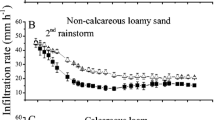Abstract
During rainfall events, macropores are generally considered to play a dominant role in infiltration after matrix ponding has occurred. Once ponding has been initiated on the soil matrix, surface runoff may be generated at rainfall intensities less than the saturated hydraulic conductivity of the soil. The amount of runoff will depend on detention storage and how efficiently the surface flow is captured by soil macropores. The efficiency of surface water removal by macropores is diminished if surface vents become clogged sealed by washed-in sediment during the runoff event.
Post-event opening of surface vents by the animals that created them can remove evidence of the sealing process and so it is particularly important to examine the temporal stability of the soil surface during rainfall events.
In this paper evidence of macropore clogging and post-event clearing of the surface vents is presented. A fine sandy loam passed through a 2 mm diameter sieve was packed into two boxes, each with a surface area of 0.5 m2. The boxes were irrigated at 28 mm h−1 using a low energy rainfall sprinkler. This application rate exceeded the saturated hydraulic conductivity of the soil matrix. After measuring runoff and infiltration from the boxes, one box was held as a control and the second was inoculated with earthworms. After four weeks the inoculated box had a burrow density at the soil surface of 380 m−2, with an average diameter of 5 mm.
Macropore sealing occurred immediately after ponding and runoff from the macroporous soil was only 10.7% less than a control with no macropores. Within 24 h after cessation of simulated rainfall the earthworms had cleared washed in material from over 95% of burrow vents. Time to matrix ponding was well predicted using hydraulic parameters characteristic of the soil matrix, indicating that matrix sealing was not significant under the experimental conditions.
Similar content being viewed by others
References
Braud J., De Condappa D., Soria J.M., Haverkamp R., Angulo-Jaramillo R., Galle S. & Vauclin M. 2005. Use of scaled forms of the infiltration equation for the estimation of unsaturated soil hydraulic properties (the Beerkan method). Eur. J. Soil Sci. 56: 361–374.
Broadbridge P. & White, I. 1987. Time to ponding: comparison of analytic, quasi-analytic and approximate predictions. Water Resour. Res. 23: 2302–2310.
Capowiez Y., Monestiez P. & Belzunces L. 2001. Burrow systems made by Aporrectodea nocturna and Allobophora chlorotica in artificial cores: morphological differences and effects of interspecific interactions. Appl. Soil Ecol. 16: 109–120.
Chadoeuf J., Kretzschmar A. & Smettem K.R.J. 1994. An analysis of the links between earthworm cracks and burrows in the soil. Biometrics 49: 1237–1244.
Clothier B.E. & White I. 1981. Measurement of sorptivity and soil water diffusivity in the field. Soil Sci. Soc. Amer. J. 45: 241–244.
Clothier B.E. & Smettem K. 1990. Combining laboratory and field measurements to define the hydraulic properties of soil. Soil Sci. Soc. Amer. J. 54: 299–304.
Hamblin A.M. 1984. The effect of soil surface properties on the water balance of a xeralfic alfisol. Soil Till. Res. 4: 543–559.
Jarvis N. 2007. A review of non-equilibrium water flow and solute transport in soil macropores: principles, controlling factors and consequences for water quality. Eur. J. Soil Sci. 58: 523–546.
McKenzie N., Smettem K.R.J. & Ringrose-Voase, A.J. 1991. Evaluation of several methods for inferring air and water properties of soils from field morphology. Aust. J. Soil Res. 29: 587–602.
Parlange J.-Y. & Smith R.E. 1976. Ponding time for variable rainfall rates. Can. J. Soil Sci. 56: 121–123.
Ross P.J. & Bridge B. 1985. A portable, microcomputer-controlled drip infiltrometer. I. Design and operation. Aust. J. Soil Res. 23: 383–391.
Rovira A., Smettem K.R.J. & Lee K. 1987. Effect of rotation and conservation tillage on earthworms in a Red-brown earth under wheat. Aust. J. Agric. Res. 38: 829–834.
Smettem K.R.J., Rovira A., Wace S.A., Wilson B. & Simon A. 1992. Effect of tillage and rotation on the surface stability and chemical properties of a red-brown earth (xeralf) under wheat. Soil Till. Res. 22: 27–40.
Soil Survey Staff. 1988. Keys to Soil Taxonomy (4th printing). SMSS Tech. Monogr. No. 6. Cornell Univ., Ithaca, NY. USA.
Somaratne N. & Smettem K.R.J. 1993. Effect of cultivation and raindrop impact on the surface hydraulic properties of an Alfisol under wheat. Soil Till. Res. 26: 113–123.
White I. & Broadbridge P. 1988. Constant rate rainfall infiltration: a versatile non-linear model. 2. Applications of solutions. Water Resour. Res. 24: 155–162.
White I., Sully M.J. & Melville M.D. 1989. Use and hydrological robustness of time-to-incipient ponding. Soil Sci. Soc. Amer. J. 29: 1343–1346.
Author information
Authors and Affiliations
Corresponding author
Rights and permissions
About this article
Cite this article
Smettem, K.R.J. The relation between runoff generation and temporal stability of soil macropores in a fine sandy loam. Biologia 64, 470–473 (2009). https://doi.org/10.2478/s11756-009-0107-6
Received:
Accepted:
Published:
Issue Date:
DOI: https://doi.org/10.2478/s11756-009-0107-6




